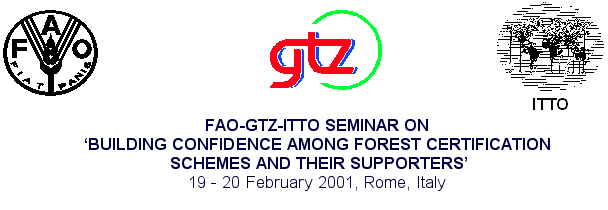|

Certifier Perspectives on Mutual Recognition and Joint
Certification
Richard Z. Donovan
Chief of Forestry and
SmartWoodDirector, Rainforest Alliance
FAO-GTZ-ITTO Seminar on
Building Confidence Among Certification Schemes and
Their Supporters
Rome, Italy
February 20,
2001 |
Background
� 10 years of experience in forest management ( FM) & chain of
custody (COC) certification
� Experience with FSC, ISO, CSA, LEI, NTCC & PEFC
� 18 years of prior experience in logging, environmental advocacy,
rural development, forestry consulting, and community forestry
� A system is a means to an end; it is not an end in itself. If the
system doesn't achieve intended outcome, the system is
dysfunctional.
� Outcome - Certified products from ecologically viable forest
ecosystems and peaceful, productive human communities. |
The Difficulties of This MR
Conversation
� Each of us is vested in our own system.
� We have different levels of understanding in this room.
� We slip too easily into comfortable dogma...
� Our systems are both "top-down" (consistent policy) and
"bottom up" (regionally driven).
� We don't want to admit our weaknesses, particularly when they are
pointed out by our "opponents".
� We don't trust each other. Trust is built on experience and there are
no shortcuts. |
Why is MR important?
� It is a vehicle for us to discuss and either resolve or accept our
differences.
� MR responds to our desire for "order in the universe".
� MR offers us an opportunity to re-examine our motives. Our motives
are multiple and can be different, e.g. market dynamics vs.
attainment of SFM vs. conflict resolution vs. peer respect.
� MR can be a useful tool for exploring innovative certification
tools & discarding less effective ones... |
What do you want to
"mutually
recognize"?
Should we MR:
� each other? Do we really want to recognize each other? Wouldn't it be
easier if "you" just went away...
� each system's strengths and weaknesses
� similarities and differences between systems
� the different values represented by our systems
� that each system has different perspectives on "acceptable" levels of
internal difference in performance standards for different regions and
countries |
The nature of our standards and
values
In our experience, this type of certification:
� requires treatment of social and indigenous issues, with the
assumption that the public cares;
� questions the primacy of forestry that is driven too often by
short-term financial gain and has a negative impact on the ecological
value of forests and the quality of life in local communities;
� incorporates chain of custody (COC) certification, with the
assumption that the public cares "where wood products come from"; and,
� attempts to be a fair at international & regional
levels. |
We are all struggling with...
� Inter-country, region & culture notions of equivalency
� The practical implications of COC certification
� The reality that wood competes with other building materials where
certification plays less of a role
� The limits of certification as a tool for resolving conflict
� Relatively new certification models and systems that are imperfect
and need to improve
� The fact that we seem to be asking certification to resolve really
big philosophical issues, e.g. consumption, our vision for forests in the
future, and the role of government vs. corporations vs. civil
society |
Fundamental Technical Issues
Though there may be few technical differences in number, the
implications of these "few" differences for MR are huge.
� Stakeholder "notification" versus "consultation and resolution" - the
public appears to want resolution
� Resolution of customary indigenous rights versus modern property
rights; but what level of reconciliation is "certifiable"?
� When, where and how do we conserve, versus restore, High Conservation
Value Forest (HCVF)
� What is an acceptable philosophy on the use of chemicals; the public
seems to prefer use reduction, but at what cost? |
The Political Nature of
Standards
There are political challenges embedded within standards.
Example #1: Contrary to "doctrine", COC certification is not a
fundamental barrier. There are complicated COC challenges, but if creative
COC policies are encouraged, we can address the challenges.
Example #2: Standards aren't just science. Science won't solve the
issues. Nobody has a monopoly on "good science". Standards represent both
the "art and science of tending the forest" (the definition of forestry),
e.g. BMPs.
Example #3: If region-specific standards don't resolve difficult
issues, certifications will not be accepted by the public, e.g. indigenous
& group certification issues in British Columbia, Indonesia and
Sweden. |
What do certifiers need?
� "Approximate" technical equivalency within a system (e.g. too much
inter-country variation is very risky)
� Policy clarification on indigenous issues, HCVF, use of chemicals,
forest conversion, etc. - because the public demands it
� Procedural equivalency within a system & between countries -
stakeholder consultation, public summaries, public statements, labeling,
accreditation demands, etc.
� Certification systems that consistently make the same demands of each
certifier
� Orderly, robust systems that allow and foster innovation |
A suggested path to
MR...
� A plea - please, no more new structures or institutions
� The UKWAS and LEI examples are extremely useful
* resolving conflict and establishing trust takes time
* "devil is in the detail"; take the time to do it
* MR can only happen with equivalency
* standards structure differences shouldn't prohibit
equivalency
� Joint certification can be a step towards MR |
Final Observations
� MR conflict generates unacceptable financial and social costs to
forests and society
� Superficial MR will generate unacceptable future costs
� Discuss equivalency mechanisms (accreditation, FM and COC standards
and certification processes) in specific terms; generalizations are very
frustrating
� The foundation for MR must be based on practical, applied experience
- not just document analyses.
� For MR to have credibility, it must be based on equivalent outcomes
in the forest and community. |
|



